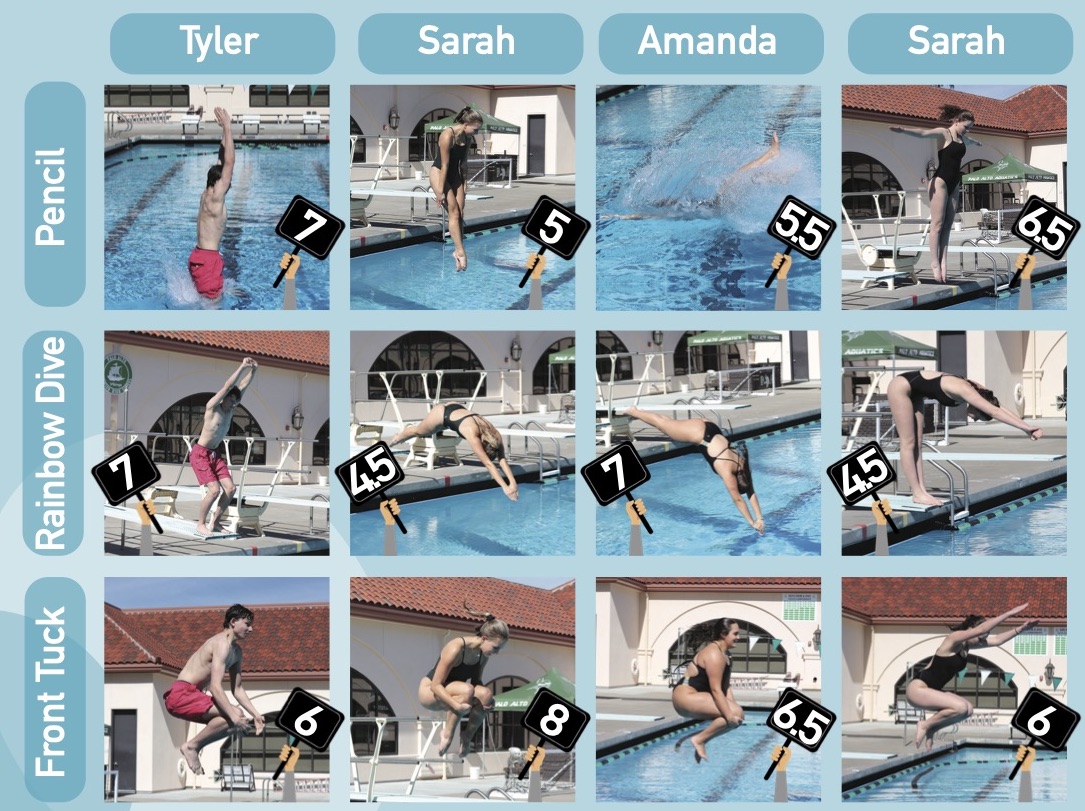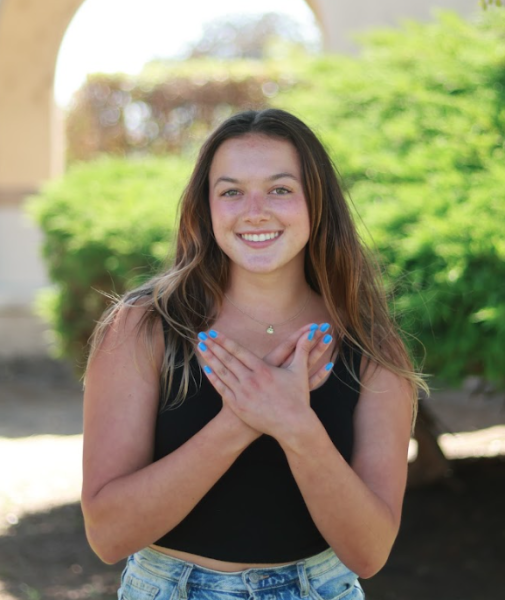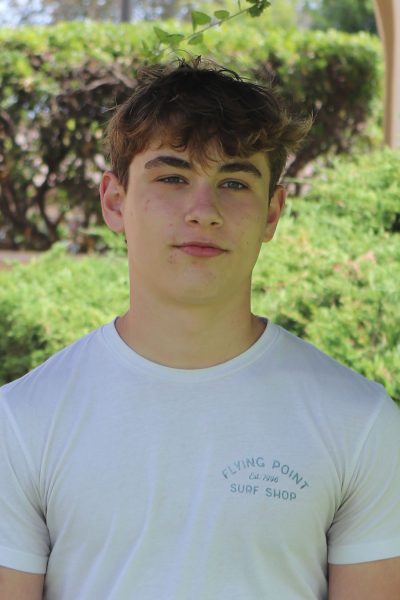Going up on a platform dozens of feet above deep water and jumping off of it again and again may not seem like everyone’s cup of tea, but Paly’s diving team is awash with talented divers who eagerly approach the challenge of completing difficult dives to perfection. They undeniably make it look easy, but how hard is it, really? Viking took to the board to find out in this issue’s Viking tries.
The Sport
Diving is a very niche and often overlooked sport. Requiring flexibility to get into small tuck and pike flipping positions, strength to achieve elegant flipping positions and gain height off the diving board, elegance that makes every dive look easy, and an incredible amount of bravery to conquer impressive skills and tricks, diving is a more unpopular sport. Good diving takes strength from almost every muscle in the body as well as an incredible amount of mental strength. When learning new dives with more twists, flips, and directions for flipping, fears develop about getting lost in the air, hitting the diving board, and flopping in the water.
In springboard and platform diving, there are three main apparatuses, the 1 meter springboard, 3 meter springboard, and platform. The platform event includes three heights, 5 meter platform, 7.5 meter platform, and 10 meter platform. At the Olympic level, the platform event only consists of dives from 10 meters. Here at Paly (the high school level), there is only 1 meter springboard diving. High school diving only offers 1 meter springboard diving due to safety concerns and inclusivity for people of all levels – beginner to advanced. Beyond the 1 meter event, the sport can get complicated. People complete variations of anywhere from 2 to 4.5 flips, some involving twisting too. Fortunately, the staff would not be embarking on these crazy dives.
Viking Learns the Basics
In light of the the Paly Swim and Dive team kicking off the season and defending some CCS titles, Viking magazine staff members sophomore Scarlett Frick (swimmer and water polo player), sophomore Sarah Thieman (swimmer and field hockey player), sophomore Amanda Goody (swimmer and water polo player), and senior Tyler Frick (basketball player) worked with Paly diving coach (and former member of the national team of Canada) Megan Parker to try out the sport.
Parker worked with the staff members to teach them four very basic dives. Our staff quickly learned that there’s a plethora of work and body control put into diving.
“I didn’t realize a lot of little technical things like balancing on the diving board, landing a certain distance from the board, how tight you have to be in the air, having your feet pointed and together, how to make minimal splash, and grabbing your hands a certain way just to do a very simple dive,” Scarlett Frick said.
The staff members felt overwhelmed by the amount of techniques it takes to properly execute a dive.
“Just from watching it, the divers make it look so graceful and effortless, and then doing it you realize, oh, I have to stay really tight, like squeezing your core and pointing your feet and keeping your hands tight and just lots of other little things,” Thieman said. “There’s just so many things to think about when diving.”
Staff Takes the Plunge(s)
Despite some trepidation, the staff members picked up more confidence after their first dives. Each staff member started off with a front jump straight (commonly known as a pencil dive). Learning to do a proper take off from the diving board and the technique to look graceful in the air, every staff member successfully completed a front jump straight.
Moving on to a front jump with a tuck position, the staff members were a little more shaky. Their first attempts were used to sort out their confusion of when (in the air) they should get into the tuck and avoid colliding with the water in a cannonball. On their second attempt, each staff member was able to develop better timing, which will prove important for when they later learn a front dive tuck, which is where you enter head first, instead of feet first.
As the staff moved on to learn their third dive, a front line-up (a dive where instead of jumping and going in head first, the diver just leans forward and falls into the water head first), they are a bit more nervous for their first head first dive.
After getting a hang of the front line-up, the staff was ready to learn a front dive straight, where the diver jumps up and dives down in a rainbow shape, a bit like a swimming dive.
“Learning the front dive felt scarier because with adding a jump to the dive, there was so much more to think about and I didn’t want to get hurt if I didn’t do the proper hand position going into the water,” Goody said.
Given the importance of confidence to excel in the sport, Coach Parker comforts staff members’ fears in learning certain dives with how it’s common to experience fear in diving.
“Diving is a sport where on top of needing strength and needing flexibility, you also have to have mental toughness because it is a scary sport,” Coach Parker said.
Getting over their fears, the staff was able to perform some strong front dive straights.
“The coach gave really helpful instruction that made everything easier and broke things down well, so after I got off my first attempt, I was like oh this isn’t that bad… and when you apply the critiques from the coach it’s crazy what differences it can make, even in my very short amount of time learning to dive,” Thieman said.
To wrap up their diving experience, our staff “competed” their newly learned front jump straight, front line up, and tuck to be scored by Coach Parker. The staff showed off their new knowledge of the sport as each person was able to use the right technique for entering the water tight to make a smaller splash. While Thieman’s and Scarlett Frick’s strengths were their elegance and grace going off the board, Tyler Frick showed good body control and Goody showed good air awareness. Tyler Frick ultimately had the highest average score, taking the victory.
Takeaways
Our staff gained many new insights on the many layers of physical and mental skills and techniques that it takes to be a diver.
“Because I’m a swimmer, I have seen diving before, but I never really thought much about the work that gets put into it and how much technique it takes,” Scarlett Frick said. “If I were to do a much harder dive, I don’t know how you’re able to think about all those little techniques and just all the nerves you have to suppress to do the harder dives.”
In addition, the staff members learned a lot more just about how the sport works.
“I never knew how they had to compete so many dives,” Scarlett Frick said. “I thought you picked one dive, said that’s my dive, and just got good at that, but you have to learn many dives in so many different directions and have the confidence to do them with just one chance in the meet.”
Overall, our staff exceeded expectations on the sport and had a fun time learning all the factors of diving that aren’t super obvious when just hearing about the sport.
“I thought I wasn’t going to be very great because I don’t have experience in gymnastics or anything like that, and it felt a lot harder to do the dives in comparison to watching actual divers and they make it look so graceful and effortless,” Goody said. “I wasn’t looking forward to it in the beginning, but it was fun once I had done my first couple dives and followed the coach’s instructions.”
Ultimately, each of our staff members developed a new respect for diving after trying out diving. It’s a sport that looks a lot easier than it actually is after taking account of all the aspects needed to consistently get good scores.





